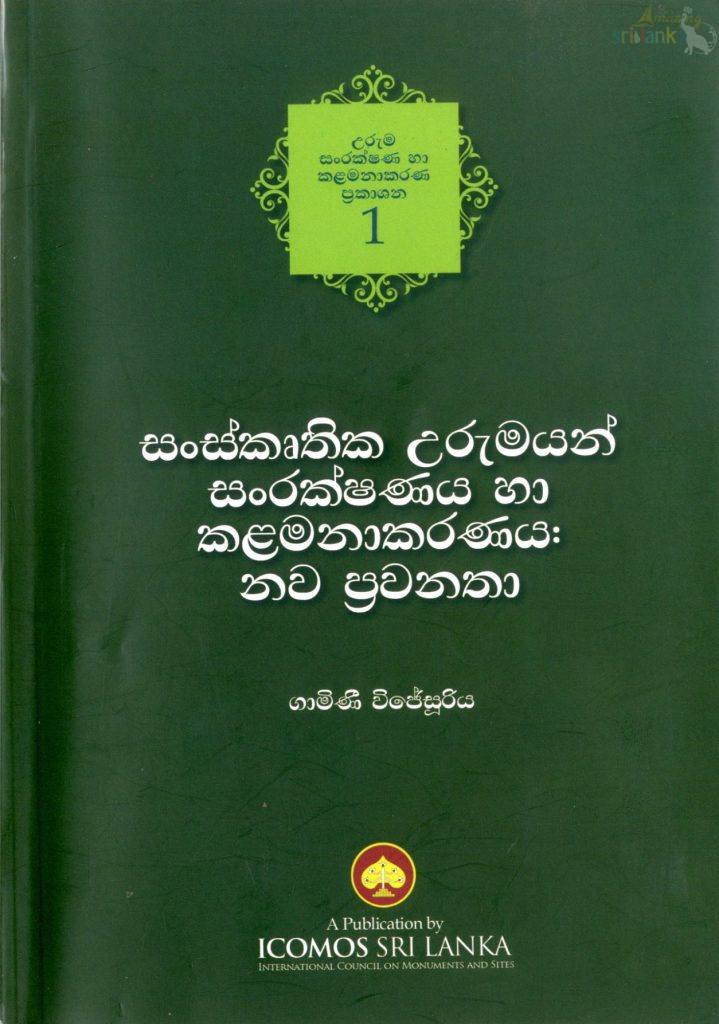Redefining Cultural Heritage

Part 1
In Conversation with Dr.Gamini Wijesuriya
By Ama H.Vanniarachchy
“That is why when they colonize you. They shame your culture and undermine it so that you might think it is not important. They want you to forget your culture and heritage which is your power. Losing your identity is losing your power. It will make you vulnerable.”
De philosopher DJ Kyos
Sri Lanka is blessed with a rich cultural heritage, which is a combination of a unique intangible heritage as well as a precious tangible heritage. The tangible heritage we commonly refer to is the antiquities or archaeological sites of the country. This is the part which we can see, feel and touch. These are also known as monuments and sites. These remains are remnants of the past culture and civilization that existed and some still extant in Sri Lanka.
However, we also have heard of an intangible part of the Sri Lankan culture which we know as rituals, beliefs, customs, festivals, pageants, crafts, knowledge systems, and various religious and cultural performances. There is also a part that mostly goes unnoticed, that is always attached to the tangible heritage as well the intangible heritage; that is the consciousness of the people who have faith and love for their heritage. This is the invisible string which is intellectual and spiritual values that keep the people connected with their cultural heritage. When this invisible code is faded away, along with it a set of values that maintains the integrity and the authenticity of cultural heritage gradually starts to fade away.
Hence, preserving or conserving the cultural heritage means, not only protecting the sites and monuments or the physical parts, but also preserving all the values including intangible dimensions including beliefs, traditional knowledge systems, rituals, pageants, crafts, practices, and festivals, customs, etc. The tangible heritage loses their values once the intangible part has faded away. If we say this in a simple example, what is the purpose of a stupa if the pilgrims and monks are not allowed to perform their age-old beliefs and rituals associated with them? Why were the temples first built for and for whom?
A few years ago, when the Mihintale Mihindu Seya, which is now in a ruined condition, commenced renovations, there was an interesting discussion among scholars and the public about the task. Some were arguing that the ruins of the stupa must have been left to be how it is, in their old brick form while some argued that the stupa should be or could be renovated and whitewashed.
There had been an argument if the largest two stupas we have, the Jetavana stupa and the Abhayagiri stupa should be completely restored and whitewashed or should be left as they are, with the broken kotha and the brick dome in ruined condition.
However, at present many other ancient stupas are being restored and still, the debate goes on. Once, in 2021 a descendant of H.C.P.Bell contacted the writer and shared her views on the construction of the Ruwanweli seya saying that it was renovated by Buddhist monks and the ‘ancient value’ has been lost and the ruins have been ruined. Isn’t it echoing the voice of the colonial masters? Indeed, the colonial masters called the section of the community who restored stupas ‘pious vandals’.
It seems that the heritage sector in Sri Lanka is somewhat dealing with many misunderstandings and confusion regarding conservation, preservation, and management. This may be due to the fact that we are slow in updating our knowledge parallel to the world and that we have not decolonized many things in the heritage sector. It is important to have a knowledge system of our own, suitable to the local context while recognizing the global trends.
Still, for us, the idea that Jethawana stupa is being whitewashed and venerated is slightly shocking. Even the restoration work at Maha Stupa was done with much objection and criticism rising during the time as mentioned above. When the Dalada Maligawa or the Temple of Tooth Relic, the most sacred Buddhist shrine in Sri Lanka was bombed 23 years ago (25 January 1998), the construction work faced similar yet milder arguments regarding the restoration work.
We do not intend to say that all ancient temples should be restored and whitewashed and new constructions should be allowed as they please; they should be done maintaining the religious and aesthetic, historic, and many other values these places have. Some of the modern constructions are extremely damaging to the aesthetic beauty as well as the calming, religious, and spiritual environment that these places naturally have.
A series of research articles written by Archaeologist Dr. Gamini Wijesuriya that were published internationally is an eye-opener and surely change the perspective we have about heritage and helps in broadening our vision.
Dr.Wijesuriya was in charge of the conservation work as the Director of Conservation of the Department of Archaeology and became the first Asian staff member of the International Center for the Study of Preservation and Restoration of Cultural Property popularly known as ICCROM based in Rome serving more than 15 years. He is now Special Advisor to the DG of ICCROM, Rome, Italy, Special Advisor to the DG of WHITRAP Shanghai, China, and President of the International Council on Monuments and Sites (ICOMOS) Sri Lanka. These series of articles, translated into Sinhala are now published as a series of books by ICOMOS Sri Lanka.
Our resource of ours today is the article titled, Managing Cultural Heritage, originally published as a chapter in Managing Cultural World Heritage, the Resource Manual published by UNESCO in 2013. The Sinhala adaption and an expanded version of this are available as Sanskruthika Urumayan Sanrakshanaya ha Kalamanakaraya; Nawa Prawanatha, published by the ICOMOS Sri Lanka.
What is meant by Heritage?
Dr. Wijesuriya argues that the definition of ‘Monuments and Sites’ that are being in use in modern times are based on such criteria as the age, the ruined status, and the physical dimensions. Dr.Wijesuriya says that this definition is narrow and restricted. In the 1960s the term ‘Cultural Property’ came into use and in the 1970s the term ‘Cultural Heritage’ was in use. Since then, many attempts have been made to broaden the definition and understanding of ‘Heritage’.
Dr.Wijesuriya explains in his book that evidence of past societies can provide a sense of belonging and security to modern societies and be an anchor in a rapidly changing world. In many societies, too, heritage can be an important definer of identity. Understanding the past can also be of great help for managing the problems of the present and the future.
The range of what is regarded as heritage has broadened significantly over the last half-century.
Heritage properties tended to be individual monuments and buildings such as places of worship or fortifications and were often regarded as standalone, with no particular relationship to their surrounding landscape and context. Today, there is general recognition that the whole environment has been affected by its interaction with humans and is therefore capable of being recognized as heritage.
Notably, after the 1990s, the concept of Heritage was fast expanded. Prior to that monument, temples, palaces, and fortifications, were considered isolated from intangible aspects and the surroundings including their natural and cultural landscape, along with the communities around them. They were known as individual monuments and sites with no particular relationship to their surrounding landscape.
However, today, there is general recognition that the whole environment has been affected by its interaction with humanity and is therefore capable of being recognized as heritage. It becomes even more necessary to make judgments about what is significant and what does not.
According to Dr.Wijesuriya, this expansion of the concept of heritage has meant in turn an enormous expansion in the range of types of structures and places treated as heritage.
The World Heritage Convention recognizes that heritage can be defined as ‘monuments, groups of buildings and sites. In practice, a broad set of typologies has developed that includes: urban centers, archaeological sites, industrial heritage, cultural landscapes, and heritage routes. This greatly increases the range of places and landscapes that has to be managed by heritage managers and thus widens the range of skills required. Managers are also expected to recognize ever-increasing factors affecting heritage that can have adverse impacts as well as opportunities.
He also says that the main tool in identifying and managing heritage is the concept of ‘Values’. Values mean, why a place, a monument, or a site is important, and to whom (this varies among individuals, groups, ethnicities, etc) not just the experts or heritage specialists. Assessment of such values collectively is therefore mandatory and in the process, you identify tangible and intangible attributes that carry the said values. This sets the foundation for their conservation and management.
Values are intrinsic or attributed to the people. Values could be understood and expanded such as religious, archaeological, scientific, economic, memorial, cultural, etc. Dr. Wijesuriya also explains that ‘heritage’ places can have more than one value. Therefore, when planning conservation and management programs, all these values should be taken into consideration.
This means that a heritage management system and all those involved in it must have the capacity for influencing decisions about all values of a heritage place collectively assessed by recognizing the context. Change in the surroundings is probably inevitable but it should not damage the values (in the case of a World Heritage property, the Outstanding Universal Value) of the heritage place. It can in fact be a catalyst that unlocks new forms of support, in turn affecting significance.
The book deals with the following themes:
1. What is heritage, and why manage heritage?
2. Placing heritage concerns in a broader framework
3. Heritage management and sustainable development
4. Heritage management systems
5. Evolution and approaches to the management of heritage
6. Management of change
The other books in the series are:
Preservation of one’s own culture does not require contempt or disrespect for other cultures.
To be continued…
Dr.Gamini Wijesuriya
Uncategorized, Ama H.Vanniarachchy, Gamini Wijesuriya, Sri Lankan archaeology, SRI LANKAN HISTORY
